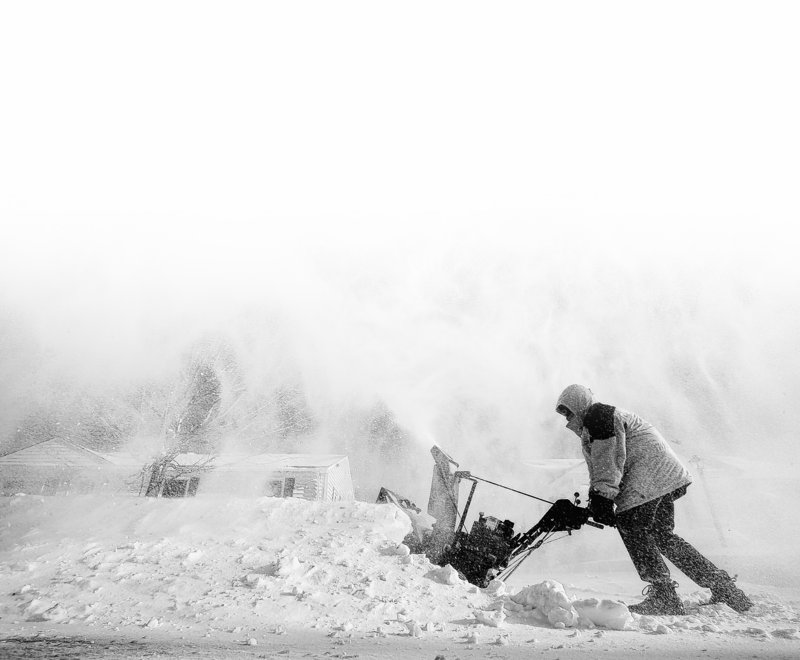HARTFORD, Conn. — In Rhode Island, a mayor tells parents of snowbound schoolchildren to “hang in there.” Atlanta has blown nearly all the money it set aside to clear the streets. In Connecticut, they’re literally praying for winter to end. And at travel agencies, the phones are ringing with callers pining for tropical vacations – when the skies clear up enough to fly out, that is.
Just one month into winter, major cities up and down the East Coast have already gotten clobbered with more snow than they usually get all season, a one-storm-after-another barrage that is eating up snow-removal budgets and forcing schools to close.
And officially, winter still has two months left.
A new half-foot of snow tested the patience of residents in the Hartford area Friday, complicating a morning commute already made arduous by mountainous snowbanks that have not melted since a record-setting snowfall last week. Forecasters are calling for below-zero temperatures in New England over the weekend, followed perhaps by another big snowstorm along the East Coast, maybe even a blizzard.
“I’m spending a lot of time praying for spring,” said Mark Boughton, mayor of Danbury, Conn., where back-to-back storms have been so bruising that crews haven’t even had a chance to take down Christmas lights on Main Street.
The culprit is an unpredictable phenomenon called the North Atlantic Oscillation, an interaction of subtropical highs and polar lows that controls the flow of air along the East Coast, said Art DeGaetano, a Cornell University professor who directs the school’s climate center. The colder air turns precipitation that would normally fall as rain into snow – even in the South.
Georgia officials think their $10 million reserve fund for emergencies is probably close to depleted. Fannin County, in northern Georgia, has lost nine school days and was foiled in a controversial attempt to keep up by holding classes on Martin Luther King Jr. Day. “It’s been one heck of a winter,” said schools Superintendent Mark Henson.
The storms have delayed or canceled countless flights at airports throughout the region, most famously during the post-Christmas blizzard in the New York area, where thousands of holiday travelers were stranded for days and the mayor faced a political crisis because of slow cleanup.
The nation’s largest city burned through its entire snow removal budget of nearly $40 million on that storm, the season’s first. The storm also came on a Sunday, meaning millions of dollars in overtime paid to city workers.
The city has had three more snowfalls since then, and Mayor Michael Bloomberg has dismissed questions about how it will pay for further cleanup. Streets are cleared first, he says, and the city figures out afterward where it can shift money.
In Wethersfield, Conn., the phone at Wethersfield Travel rings steadily with stranded travelers seeking help – and with new customers seeking a sunny respite.
“We’re hearing from a lot of people who are sick of the snow and say they want to get away fast to somewhere warm,” company owner Martha Kirsche said.
The season started out with little hint of what was to come.
The National Weather Service’s official long-range winter forecast back in October amounted to a flip of the coin: The Northeast and Mid-Atlantic had equal chances of being snowier and colder than normal, and warmer and drier than normal.
The folks at the New Hampshire-based Old Farmer’s Almanac and the Maine-based Farmers’ Almanac didn’t fare much better, the first predicting colder but less snowy weather for the eastern half of the U.S. and the latter forecasting colder weather and average snowfall.
“I got the cold part right,” said Peter Geiger, editor of the Farmers’ Almanac.
It’s true that temperatures in much of the East have been 2 to 4 degrees below normal in December and January, DeGaetano said. In Washington, the temperature was 6 to 8 degrees colder than average in December and 2 to 3 degrees colder in January.
Still, forecasters say it is too soon to call this winter record-breaking.
“We’ve got a long way to go,” said David Stark, a meteorologist with the National Service in Upton, N.Y., noting that New York City’s 36 inches is a far cry from the record 75.6 inches that fell in 1995-96.
In Buffalo, N.Y., which gets about 93 inches of snow each season, residents yawn at suggestions that this winter is especially harsh. The lakeside city had received about 56 inches by Friday, typical for this time of year.
Send questions/comments to the editors.



Success. Please wait for the page to reload. If the page does not reload within 5 seconds, please refresh the page.
Enter your email and password to access comments.
Hi, to comment on stories you must . This profile is in addition to your subscription and website login.
Already have a commenting profile? .
Invalid username/password.
Please check your email to confirm and complete your registration.
Only subscribers are eligible to post comments. Please subscribe or login first for digital access. Here’s why.
Use the form below to reset your password. When you've submitted your account email, we will send an email with a reset code.